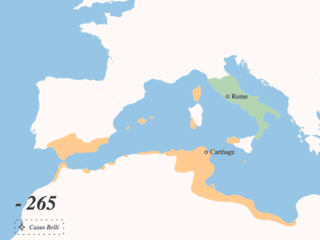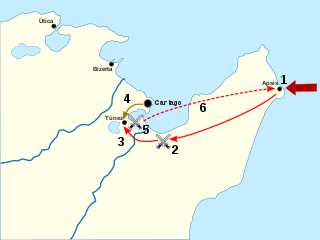
The First Punic War was the first of three wars fought between Rome and Carthage, the two main powers of the western Mediterranean in the early 3rd century BC. For 23 years, in the longest continuous conflict and greatest naval war of antiquity, the two powers struggled for supremacy. The war was fought primarily on the Mediterranean island of Sicily and its surrounding waters, and also in North Africa. After immense losses on both sides, the Carthaginians were defeated.

The Punic Wars were a series of wars between 264 and 146 BC fought between Rome and Carthage. Three conflicts between these states took place on both land and sea across the western Mediterranean region and involved a total of forty-three years of warfare. The Punic Wars are also considered to include the four-year-long revolt against Carthage which started in 241 BC. Each war involved immense materiel and human losses on both sides.

The Battle of Agrigentum was the first pitched battle of the First Punic War and the first large-scale military confrontation between Carthage and the Roman Republic. The battle was fought after a long siege which started in 262 BC and resulted both in a Roman victory and the beginning of Roman control of Sicily.

The Battle of the Lipari Islands or Battle of Lipara was a naval encounter fought in 260 BC during the First Punic War. A squadron of 20 Carthaginian ships commanded by Boödes surprised 17 Roman ships under the senior consul for the year Gnaeus Cornelius Scipio in Lipara Harbour. The inexperienced Romans made a poor showing, with all 17 of their ships captured, along with their commander.

The Battle of Mylae took place in 260 BC during the First Punic War and was the first real naval battle between Carthage and the Roman Republic. This battle was key in the Roman victory of Mylae as well as Sicily itself. It also marked Rome's first naval triumph and also the first use of the corvus in battle.

The Battle of Cape Ecnomus or Eknomos was a naval battle, fought off southern Sicily, in 256 BC, between the fleets of Carthage and the Roman Republic, during the First Punic War. It was the largest battle of the war and one of the largest naval battles in history. The Carthaginian fleet was commanded by Hanno and Hamilcar; the Roman fleet jointly by the consuls for the year, Marcus Atilius Regulus and Lucius Manlius Vulso Longus. It resulted in a clear victory for the Romans.

Gaius Duilius was a Roman general and statesman. As consul in 260 BC, during the First Punic War, he won Rome's first ever victory at sea by defeating the Carthaginians at the Battle of Mylae. He later served as censor in 258, and was appointed dictator to hold elections in 231, but never held another command.
The naval Battle of Drepana took place in 249 BC during the First Punic War near Drepana in western Sicily, between a Carthaginian fleet under Adherbal and a Roman fleet commanded by Publius Claudius Pulcher.
The Battle of the Aegates was a naval battle fought on 10 March 241 BC between the fleets of Carthage and Rome during the First Punic War. It took place among the Aegates Islands, off the western coast of the island of Sicily. The Carthaginians were commanded by Hanno, and the Romans were under the overall authority of Gaius Lutatius Catulus, but Quintus Valerius Falto commanded during the battle. It was the final and deciding battle of the 23-year-long First Punic War.

The Battle of the Bagradas River, also known as the Battle of Tunis, was a victory by a Carthaginian army led by Xanthippus over a Roman army led by Marcus Atilius Regulus in the spring of 255 BC, nine years into the First Punic War. The previous year, the newly constructed Roman navy established naval superiority over Carthage. The Romans used this advantage to invade Carthage's homeland, which roughly aligned with modern-day Tunisia in North Africa. After landing on the Cape Bon Peninsula and conducting a successful campaign, the fleet returned to Sicily, leaving Regulus with 15,500 men to hold the lodgement in Africa over the winter.

The battle of Adys took place in late 256 BC during the First Punic War between a Carthaginian army jointly commanded by Bostar, Hamilcar and Hasdrubal and a Roman army led by Marcus Atilius Regulus. Earlier in the year, the new Roman navy had established naval superiority and used this advantage to invade the Carthaginian homeland, which roughly aligned with modern Tunisia in North Africa. After landing on the Cape Bon Peninsula and conducting a successful campaign, the fleet returned to Sicily, leaving Regulus with 15,500 men to hold the lodgement in Africa over the winter.
The Battle of Panormus was fought in Sicily in 250 BC during the First Punic War between a Roman army led by Lucius Caecilius Metellus and a Carthaginian force led by Hasdrubal, son of Hanno. The Roman force of two Roman and two allied legions defending the city of Panormus defeated the much larger Carthaginian army of 30,000 men and between 60 and 142 war elephants.
Hamilcar was a general who succeeded to the command of the Carthaginians in the First Punic War. He defeated Rome's allies at the Battle of Thermae in 259 BC and killed 4,000–6,000 of them with the help of surprise and good use of military intelligence. He then captured the towns of Enna and Camarina that same year with the assistance of traitors. He was defeated at the Battle of Tyndaris in 257 BC, losing 18 ships and sinking 9 Roman ships. He failed to prevent the Roman landing in Africa, being defeated at the Ecnomus in 256 BC, one of the largest naval battles in antiquity, with the loss of 94 ships, to the Romans' 24. After the Roman invasion of Africa, Hamilcar was recalled by Carthage from Sicily. He was defeated by Marcus Atilius Regulus at the Battle of Adys in 255 BC.

The Battle of Ibera, also known as the Battle of Dertosa, was fought in the spring of 215 BC on the south bank of the Ebro River near the town of Ibera and was part of the Second Punic War. A Roman army, under the command of the brothers Gnaeus and Publius Scipio, defeated a similarly sized Carthaginian army under Hasdrubal Barca. The Romans, under Gnaeus Scipio, had invaded Iberia in late 218 BC and established a foothold after winning the Battle of Cissa. This lodgement, on the north-east Iberian coast, between the Ebro and the Pyrenees, blocked the route of any reinforcements from Iberia for the army of Hannibal, who had invaded Italy from Iberia earlier in the year. Hasdrubal attempted to evict the Romans in 217 BC, but this ended in defeat when the Carthaginian naval contingent was mauled at the Battle of Ebro River.
The Treaty of Lutatius was the agreement between Carthage and Rome of 241 BC, that ended the First Punic War after 23 years of conflict. Most of the fighting during the war took place on, or in the waters around, the island of Sicily and in 241 BC a Carthaginian fleet was defeated by a Roman fleet commanded by Gaius Lutatius Catulus while attempting to lift the blockade of its last, beleaguered, strongholds there. Accepting defeat, the Carthaginian Senate ordered their army commander on Sicily, Hamilcar Barca, to negotiate a peace treaty with the Romans, on whatever terms he could negotiate. Hamilcar refused, claiming the surrender was unnecessary, and the negotiation of the peace terms was left to Gisco, the commander of Lilybaeum, as the next most senior Carthaginian on the island. A draft treaty was rapidly agreed upon, but when it was referred to Rome for ratification it was rejected.
The siege of Lilybaeum lasted for nine years, from 250 to 241 BC, as the Roman army laid siege to the Carthaginian-held Sicilian city of Lilybaeum during the First Punic War. Rome and Carthage had been at war since 264 BC, fighting mostly on the island of Sicily or in the waters around it, and the Romans were slowly pushing the Carthaginians back. By 250 BC, the Carthaginians held only the cities of Lilybaeum and Drepana; these were well-fortified and situated on the west coast, where they could be supplied and reinforced by sea without the Romans being able to use their superior army to interfere.
The Roman withdrawal from Africa was the attempt by the Roman Republic in 255 BC to rescue the survivors of their defeated expeditionary force to Carthaginian Africa during the First Punic War. A large fleet commanded by Servius Fulvius Paetinus Nobilior and Marcus Aemilius Paullus successfully evacuated the survivors after defeating an intercepting Carthaginian fleet, but was struck by a storm while returning, losing most of its ships.
The Battle of Thermae was a field engagement during the First Punic War that took place in 259 BC near Thermae on the northern coast of Sicily. The Carthaginian general Hamilcar surprised and defeated 6,000 allied troops of Rome.
The naval Battle of Phintias took place in 249 BC during the First Punic War near modern Licata, southern Sicily between the fleets of Carthage under Carthalo and the Roman Republic under Lucius Junius Pullus. The Carthaginian fleet had intercepted the Roman Fleet off Phintias, and had forced it to seek shelter. Carthalo, who heeded the warning of his pilots about impending storms, retired to the east to avoid the coming weather. The Roman fleet did not take any precautions and subsequently was destroyed with the loss of all but two ships. The Carthaginians exploited their victory by raiding the coasts of Roman Italy until 243 BC. The Romans did not mount a major naval effort until 242 BC.
Hasdrubal was a Carthaginian general who served during the middle years of the First Punic War, fought between Carthage and Rome, and took a leading part in three of the four major field battles of the war. He was a citizen of the city state of Carthage, which was in what is now Tunisia. His date of birth and age at death are both unknown, as are his activities prior to his coming to prominence in 255 BC. Modern historians distinguish him from other Carthaginians named Hasdrubal by the cognomen "son of Hanno".










